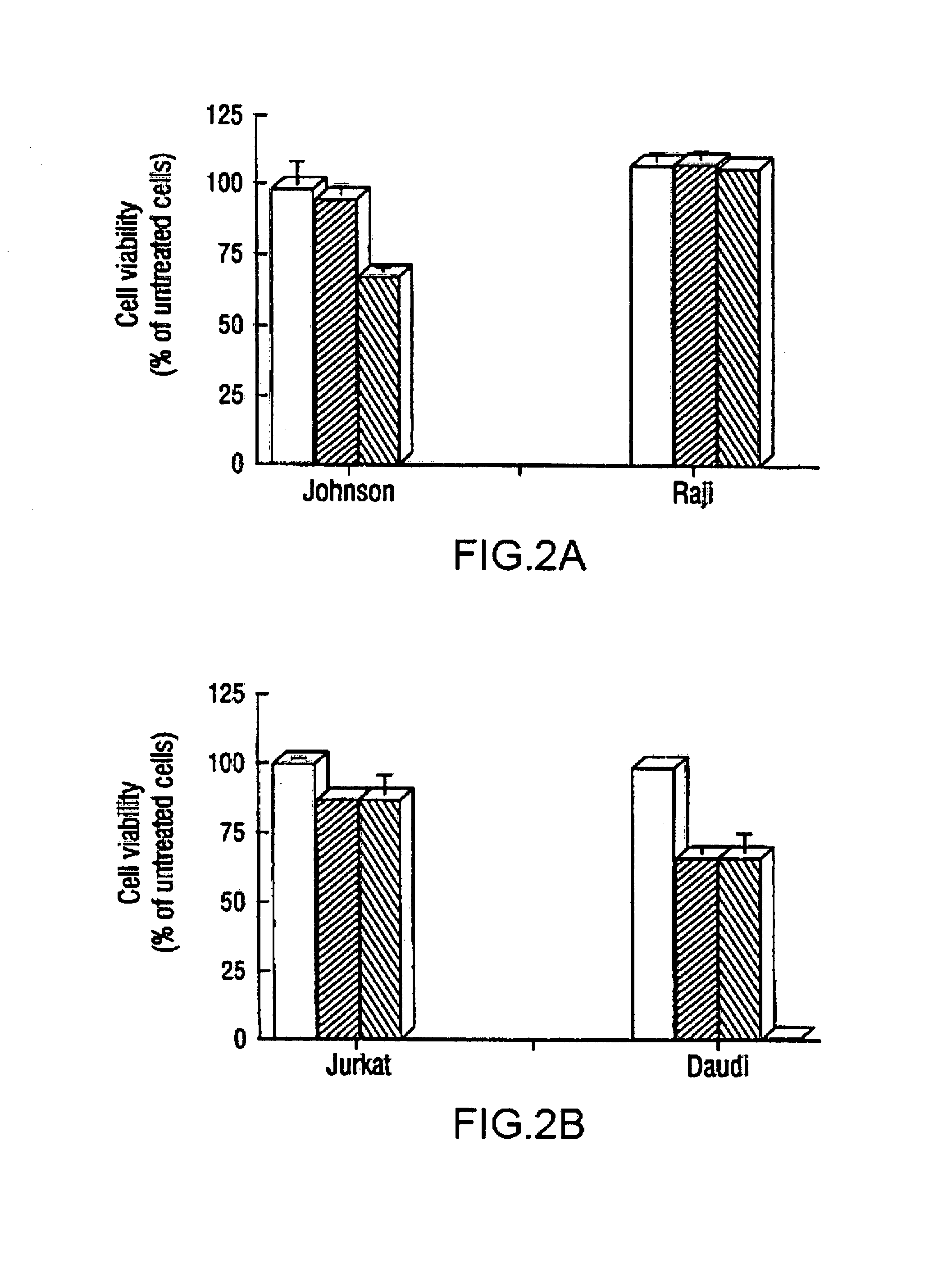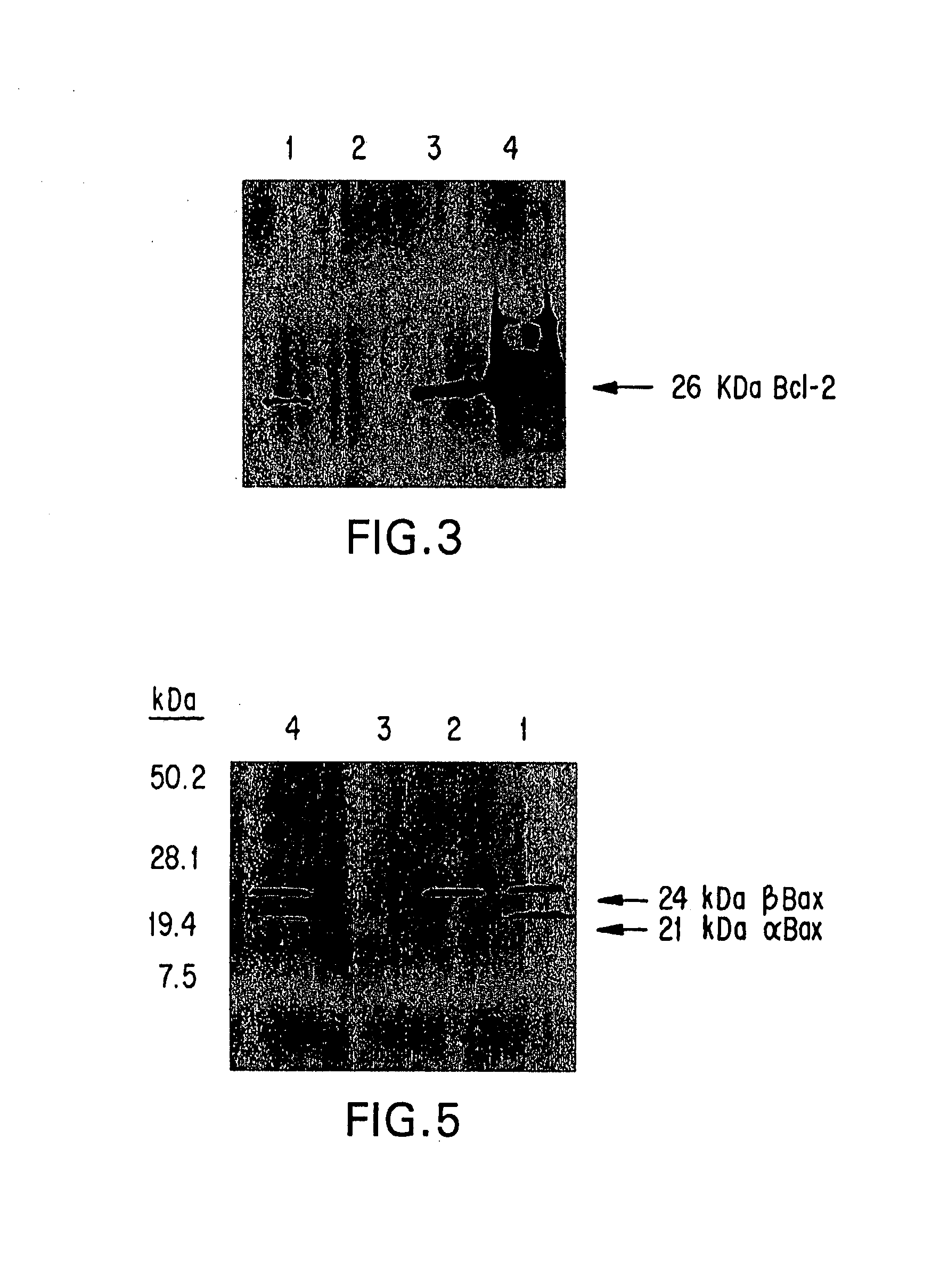Inhibition of Bcl-2 protein expression by liposomal antisense oligodeoxynucleotides
a technology of antisense oligonucleotides and bcl-2 protein, which is applied in the field of cancer therapy, can solve the problems of hampered therapeutic use of antisense oligonucleotides and low cellular uptake of oligonucleotides, and achieve the effect of increasing the effective concentration of nucleic acid species and reducing the volume of hybridization
- Summary
- Abstract
- Description
- Claims
- Application Information
AI Technical Summary
Benefits of technology
Problems solved by technology
Method used
Image
Examples
example 1
Synthesis of Oligonucleotides
[0117]Nuclease-resistant p-ethoxy oligonucleotides, non-ionic phosphodiester analogs, were purchased from Oligo Therapeutics (Willsonville, Oreg.). An oligonucleotide specific for the translation initiation site of human Bcl-2 mRNA: 5′CAGCGTGCGCCATCCTTC3′ (SEQ ID NO:1) was used as antisense oligonucleotide. Two different control oligonucleotides were used: 5′ ACGGTCCGCCACTCCTTCCC3′ (SEQ ID NO:2) (scrambled version of Bcl-2 antisense oligonucleotide) and the random sequence 5′CTGAAGGGCTTCTTCC3′ (SEQ ID NO:3).
example 2
Preparation of liposomal oligonucleotides (L-OS)
[0118]P-ethoxy-oligonucleotides dissolved in distilled water were added to phospholipids (Avanti Polar Lipids, Alabaster, Ala.) in the presence of excess tert-butanol (≧95% by volume). The mixture was frozen in a dry ice / acetone bath, lyophilized overnight and finally hydrated with HEPES buffered saline (1 mmol / L Hepes and 10 mmol / L NaCl) at a final oligonucleotide concentration of 0.1 mmol / L. Liposomal oligonucleotides (L-OS) were sonicated for 12 minutes in a bath-type sonicator. The average diameter of the particles was 100 nm±50 nm as determined in a NICOMP particle sizing system (Santa Barbara, Calif.).
example 3
Oligonucleotide Inhibition of Protein Expression
[0119]Cell Lines
[0120]Johnson cells, a human transformed FL cell line bearing the t(14;18) translocation which overexpresses Bcl-2 protein, were used. Raji and Jurkat cells, a human Burkitt lymphoma cell line and a human acute T cell leukemia cell line, respectively, were also used. Both lines express the Bcl-2 protein but they lack the t(14;18) translocation. Daudi cells, a human Burkitt lymphoma cell line which does not express the Bcl-2 protein, was used as a negative control cell line. Johnson, Raji and Jurkat cells were grown in RPMI 1640 media (GIBCO, Grand Island, N.Y.) supplemented with 10% heat-inactivated fetal bovine serum (FBS). Daudi cells were grown in RPMI 1640 media supplemented with 20% heat-inactivated FBS.
[0121]Delivery of L-OS to cells
[0122]Ten thousand cells / well were seeded in a 96-well plate in 0.1 mL of the respective medium. Cells were incubated with L-OS at final concentration of 2 to 8 μmol / L at 37° C. in a 5...
PUM
| Property | Measurement | Unit |
|---|---|---|
| Time | aaaaa | aaaaa |
| Mass | aaaaa | aaaaa |
| Length | aaaaa | aaaaa |
Abstract
Description
Claims
Application Information
 Login to View More
Login to View More - R&D
- Intellectual Property
- Life Sciences
- Materials
- Tech Scout
- Unparalleled Data Quality
- Higher Quality Content
- 60% Fewer Hallucinations
Browse by: Latest US Patents, China's latest patents, Technical Efficacy Thesaurus, Application Domain, Technology Topic, Popular Technical Reports.
© 2025 PatSnap. All rights reserved.Legal|Privacy policy|Modern Slavery Act Transparency Statement|Sitemap|About US| Contact US: help@patsnap.com



